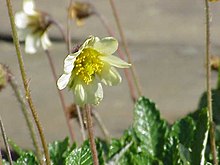Dryadoideae: Difference between revisions
Appearance
Content deleted Content added
Nadiatalent (talk | contribs) subfamily authority |
updating taxobox classification to the APG III system |
||
| Line 1: | Line 1: | ||
{{ |
{{taxobox |
||
| |
|name = Dryadoideae |
||
| |
|image = Dryas drummondii6.jpg |
||
| ⚫ | |||
| image_width = 240px |
|||
|regnum = [[Plant]]ae |
|||
| ⚫ | |||
| |
|unranked_divisio = [[Angiosperms]] |
||
|unranked_classis = [[Eudicots]] |
|||
| divisio = [[Flowering plant|Magnoliophyta]] |
|||
| |
|unranked_ordo = [[Rosids]] |
||
| |
|ordo = [[Rosales]] |
||
| |
|familia = [[Rosaceae]] |
||
| |
|subfamilia = '''Dryadoideae''' |
||
| |
|subfamilia_authority = ([[Jean-Baptiste Lamarck|Lam.]] & [[Augustin Pyramus de Candolle|DC.]]) [[Robert Sweet (botanist)|Sweet]] |
||
| |
|subdivision_ranks = [[Genus|Genera]] |
||
| ⚫ | |||
| subdivision = |
|||
| ⚫ | |||
''[[Chamaebatia]]'' [[George Bentham|Benth.]]<br> |
''[[Chamaebatia]]'' [[George Bentham|Benth.]]<br> |
||
''[[Dryas (plant)|Dryas]]'' [[Carolus Linnaeus|L.]]<br> |
''[[Dryas (plant)|Dryas]]'' [[Carolus Linnaeus|L.]]<br> |
||
''[[Purshia]]'' [[Augustin Pyramus de Candolle|DC.]] ex [[Jean Louis Marie Poiret|Poir.]] (including ''Cowania'') |
''[[Purshia]]'' [[Augustin Pyramus de Candolle|DC.]] ex [[Jean Louis Marie Poiret|Poir.]] (including ''Cowania'') |
||
}} |
|}} |
||
The '''Dryadoideae''' subfamily of the [[Rosaceae]] consists of four genera,<ref name=Potter>Potter, D., et al. (2007). Phylogeny and classification of Rosaceae. ''Plant Systematics and Evolution''. 266(1–2): 5–43.</ref> all of which share [[root nodule]]s that host the [[nitrogen fixation|nitrogen-fixing]] [[bacterium]] ''[[Frankia]]''<ref>Swensen, S.M.; Mullin, B.C. (1997). The impact of molecular systematics on hypotheses for the evolution of root nodule symbioses and implications for expanding symbioses to new host plant genera. ''Plant and Soil''. 194: 185–192.</ref>. They are sub-shrubs, shrubs, or small trees with a [[chromosome#Number of chromosomes in various organisms|base chromosome number]] of 9, whose fruits are either an [[achene]] or an [[compound fruit|aggregate]] of achenes.<ref name=Potter/> |
The '''Dryadoideae''' subfamily of the [[Rosaceae]] consists of four genera,<ref name=Potter>Potter, D., et al. (2007). Phylogeny and classification of Rosaceae. ''Plant Systematics and Evolution''. 266(1–2): 5–43.</ref> all of which share [[root nodule]]s that host the [[nitrogen fixation|nitrogen-fixing]] [[bacterium]] ''[[Frankia]]''<ref>Swensen, S.M.; Mullin, B.C. (1997). The impact of molecular systematics on hypotheses for the evolution of root nodule symbioses and implications for expanding symbioses to new host plant genera. ''Plant and Soil''. 194: 185–192.</ref>. They are sub-shrubs, shrubs, or small trees with a [[chromosome#Number of chromosomes in various organisms|base chromosome number]] of 9, whose fruits are either an [[achene]] or an [[compound fruit|aggregate]] of achenes.<ref name=Potter/> |
||
Revision as of 03:34, 12 September 2011
| Dryadoideae | |
|---|---|

| |
| Dryas × suendermannii | |
| Scientific classification | |
| Kingdom: | |
| (unranked): | |
| (unranked): | |
| (unranked): | |
| Order: | |
| Family: | |
| Subfamily: | Dryadoideae |
| Genera | |
|
Cercocarpus Kunth | |
The Dryadoideae subfamily of the Rosaceae consists of four genera,[1] all of which share root nodules that host the nitrogen-fixing bacterium Frankia[2]. They are sub-shrubs, shrubs, or small trees with a base chromosome number of 9, whose fruits are either an achene or an aggregate of achenes.[1]
Notes
- ^ a b Potter, D., et al. (2007). Phylogeny and classification of Rosaceae. Plant Systematics and Evolution. 266(1–2): 5–43.
- ^ Swensen, S.M.; Mullin, B.C. (1997). The impact of molecular systematics on hypotheses for the evolution of root nodule symbioses and implications for expanding symbioses to new host plant genera. Plant and Soil. 194: 185–192.
